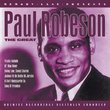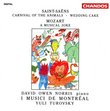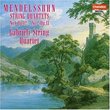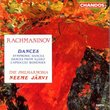| All Artists: George Dyson, Richard Hickox, City of London Sinfonia Title: George Dyson: Violin Concerto; Children's Suite Members Wishing: 0 Total Copies: 0 Label: Chandos Release Date: 6/20/1995 Genres: Special Interest, Classical Styles: Forms & Genres, Concertos, Historical Periods, Modern, 20th, & 21st Century, Instruments, Strings Number of Discs: 1 SwapaCD Credits: 1 UPC: 095115936924 |
Search - George Dyson, Richard Hickox, City of London Sinfonia :: George Dyson: Violin Concerto; Children's Suite
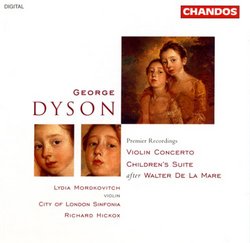 | George Dyson, Richard Hickox, City of London Sinfonia George Dyson: Violin Concerto; Children's Suite Genres: Special Interest, Classical
This is another release in Chandos's series of the music of George Dyson (1883-1964). Dyson was of Vaughan Williams's generation but seemed to have one foot in the 19th century. This is due to the fact that Charles Villi... more » |
Larger Image |
CD DetailsSynopsis
Amazon.com This is another release in Chandos's series of the music of George Dyson (1883-1964). Dyson was of Vaughan Williams's generation but seemed to have one foot in the 19th century. This is due to the fact that Charles Villiers Stanford, his teacher, emphasized strong melodies and themes. In Dyson's Violin Concerto (of 1942) the orchestra has unusually wide role; it's almost a symphony showcasing the violin. In fact, in the opening movement, the violin fairly sneaks up on the listener and remains throughout carefully framed by the orchestra. Dyson's Children's Suite after Walter de la Mare (of 1924) is here its first recording. --Paul Cook Similar CDs
|
CD ReviewsDICEY DYSON Melvyn M. Sobel | Freeport (Long Island), New York | 09/18/2000 (3 out of 5 stars) "There can be no doubt that Sir George's Violin Concerto of 1941 is a work of quality with moments of grace, grandeur and melodic beauty, but viewed in toto it doesn't quite slay any dragons. Even though I chide myself about being overly critical and, therefore, bend backwards to listen repeatedly and solicitously, with the hope that I might be just this, too often the concerto simply outstays its forty-three minute, four movement welcome and, over time, grows more tedious and empty than it first seemed. For example, the first movement Molto Moderato, alone, runs some twenty minutes--- and I have a sneaking suspicion that it just may be the straw that is breaking this concerto's back. After a lengthy orchestral introduction of promising lyricism, the violin enters at just after three minutes, gentle and flowing above a bass pizzacato, also quite promising, and remains musing for a short period until the orchestra returns to silence the soloist with a rapturous new melody. All this is wonderful, no problem, until the violin intrusively returns with a scratchy cadenza of this melody--- most annoying--- and soon the orchestra and violin combine (at about the seven minute mark) and proceed for the next thirteen minutes to ramble and meander all over the place. This, for me, pulls the movement apart and becomes increasingly frustrating. The good ideas Dyson presents soon lack cohesion, a force sorely needed here for a movement this long, obviously, and quickly become scattered. The Vivace second movement is bouncy enough but, again, seems at first better than it actually is; it soon loses its slight charm and becomes hackneyed. Most beautiful of all, and the core of the concerto, is the third movement Poco Andante, which runs over ten minutes. (And it's a wonderful reprieve from the twitchy, herky-jerky Vivace we must endure!) Although, again, rather rambling in nature, this movement does sustain a graceful lyricism throughout. (If only Dyson had distilled the opening Molto Moderato in this fashion!) The concluding Allegro (6:58) is jovial and spirited but, too, just misses the mark. High energy level is no substitute for melodic invention and, coupled with an aimless twittering about, this movement loses focus, as well. THE CHILDREN'S SUITE (1920) is a four movement affair lasting some nineteen minutes, most memorable for the first two, both charming and nostalgic. The concluding two simply seem like toss off pieces . No complaints about soloist Mordkovitch (in the concerto) or the City Of London Sinfonia under Hickox. Chandos, as well, provides a warm sound, full and rich. [Running time: 62:27] " Dyson: Essential listening Michael Gast | New York, New York United States | 06/06/2003 (5 out of 5 stars) "Dyson's Violin Concerto can easily hold its own with any similar work in the standard repertoire. It is rapturous, loving and beautifully crafted. Complaints that Dyson lacks real substance and staying power are baffling. In fact, the concerto takes on greater depth with each listening. The sheer integrity, intelligence and depth of Dyson's art is represented here. He's a composer without artifice -- one who simply and effectively conveys the sincerest expression of human yearning. In short, a Romantic lost in a world of Angst and bitterness. The Children's Suite is a delightful make-weight of such extraordinary skill and understated inspiration that some may completely miss its obvious charm. Performances from all on this disc are nothing short of world-class. The engineering is excellent. Give it a try and be surprised and how great this man's music is." Dyson Gramophone choice and Penguin Rosette winner! K. Farrington | Missegre, France | 03/13/2000 (5 out of 5 stars) "For someone of my generation it is hard to imagine how the people of Britain must have felt during the depths of 1941. London and the great cities were smouldering ruins and the whole of Europe was under Hitler's Nazi domination. It must have seemed pretty bleak indeed and Dyson's Violin Concerto, which was composed at this time is remarkable for its gentle, heart easing tones as well as its musicality. The genre of Violin Concertos had seen a revival with British composers in the 1930's with Bax and Moeran, among others, penning substantial pieces in this form. Dyson's brooding orchestral opening is not apocalyptic but pensive. It is the mood of one who asks where their life is going rather than the Berg Violin Concerto's tale of heartache due to loss. The cadenza when it comes is sweet and caressing, like a breeze of a summer morning. Dyson uses a motiff from his 'Canterbury Pilgrims', 'Now let us ride' in the scherzo and sets a scene of a fast dance or reel, a folkish but not folksong derivation. The slow movement is the heart of the work, a gentle, kind melody which is given full decoration and examination by the soloist. The finale was called by one commentator 'thoughts on the sunny south' and is a dance-like movement which is full of good humour and high spirits. The work shares something of the optimism of Moeran's more reknowned Violin Concerto rather than Bax's more gritty offering and would be a welcome item on any concert program which needs a bit of 'jollying up' but with substance and not with a mere caprice. The other item 'Children's Suite' is a four movement suite for full orchestra evoking a 1920's nursery atmosphere. The Manchester Guardian said at the time:' Dr Dyson's music does suggest something of the fireside and candlelight atmosphere, the spirit of nursery rhymes, fairy tales, drollery and fantasy...' This charming music is sensitivity itself and will appeal to all lovers of a nostalgic, naive style that composers like Ravel and Elgar attempted in some of their great works. It was good that Chandos provided us with this second work on this CD, unlike the Dyson Symphony disc. Thus they give us over a hour of this unbelievably neglected composer. This might sound a little trite but we have so little of Dyson available, every minute they give us is to be treasured! The two awards the CD won will doubtless make more people listen to this beautiful music and who knows, perhaps the BBC and Classic FM might start playing them."
|

 Track Listings (8) - Disc #1
Track Listings (8) - Disc #1